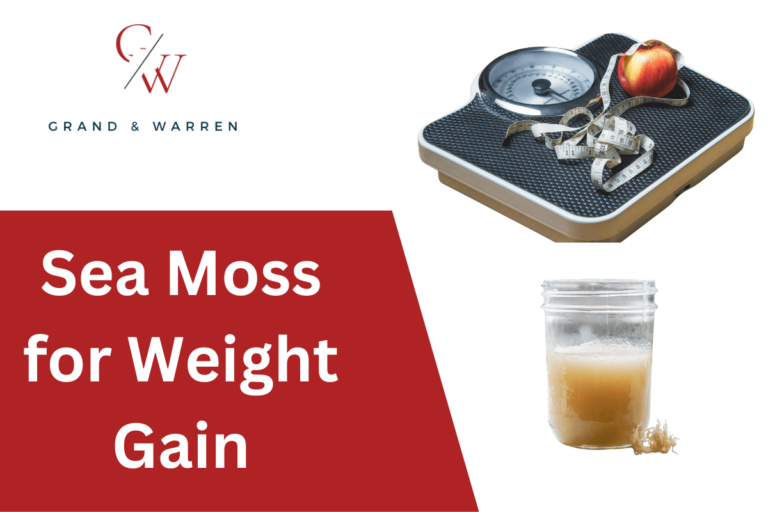Is Sea Moss Good for Diabetes? Unveiling the Nutritional Benefits
As sea moss has grown in popularity, a popular consideration is whether one of the benefits of sea moss is assistance in managing blood sugar levels. While no one expects that sea moss cure diabetes, anyone who has known diabetic patients is aware of the constant lookout for more natural ways to manage diabetes.
The interest is using sea moss supplements in a diabetes management plan stems from its rich nutritional profile, which includes vitamins, minerals, and antioxidants. Its potential role in blood sugar management comes from the presence of fiber and other compounds that might influence insulin resistance and glucose levels.
While researchers are still scrutinizing the full impact of sea moss on diabetes, early indications suggest that it could offer some benefits. However, as with any supplement or dietary addition, it’s important to consider the broader picture, including possible interactions with medications, impact on existing health conditions, and the right dosage. Individuals should consult healthcare providers before adding sea moss to their dietary regimen, and consider it as part of a comprehensive approach to managing diabetes that includes diet, exercise, and medication as prescribed by a doctor.
Key Takeaways
- Sea moss is recognized for its nutritional content, which may impact diabetes management and help improve insulin sensitivity
- Consultation with healthcare providers is crucial before incorporating sea moss into a diet
- Research is ongoing, underscoring the importance of evidence-based use of supplements for diabetes.
- Given the risk of diabetes complications, no one should make any significant dietary or medication changes without the explicit guidance and help of their physician
Diabetes Management – Sea Moss
Diabetes management involves a comprehensive approach that includes diet and lifestyle changes. Sea moss may offer several benefits that align with the needs of managing diabetes, primarily through supporting blood glucose levels control, potentially impacting heart health, and influencing thyroid function.
Blood Sugar Control and Insulin Sensitivity
My review of current research suggests that sea moss may have a role in helping to maintain healthy blood sugar levels. This is partly ascribed to the possibility that sea moss can influence insulin sensitivity. Insulin is a hormone that helps your body regulate blood sugar levels, and improving its sensitivity means the body can use insulin more effectively. Moreover, the high fiber content in sea moss could contribute to a lower glycemic index when included as part of a meal, potentially preventing sudden spikes in blood sugar levels.
Influence on Cholesterol and Heart Health
Heart health is a significant concern for individuals with diabetes as they have a higher risk of cardiovascular disease. Through my exploration, I found that sea moss contains fucoxanthin, a compound that has been linked to better heart health. Fucoxanthin may have the ability to lower bad cholesterol levels, which is beneficial since high cholesterol is a common comorbidity in people with diabetes. By helping to manage cholesterol, sea moss might indirectly support the prevention of heart disease.
Thyroid Function and Metabolism
The thyroid gland plays a pivotal role in regulating metabolism, impacting weight and energy levels. Thyroid dysfunction, including both hypothyroidism and hyperthyroidism, can affect blood sugar control. Sea moss is rich in iodine, a crucial nutrient for thyroid health, which could help maintain normal thyroid function. A well-functioning thyroid is essential for effective glucose metabolism and might assist in the management of diabetes-related symptoms. However, iodine intake should be monitored, as excessive amounts may lead to thyroid imbalance.
Sea Moss Overview
Sea moss, a type of red algae, has been recognized for its potential health benefits. Let’s explore what it is and its historical significance, particularly in relation to its use in Ireland.
What is Sea Moss?
Sea moss, or Irish moss (Chondrus crispus), is a species of red seaweed that thrives in the cool waters of the Atlantic coasts of Europe and North America. It’s known for its rich content of vitamins and minerals, which contribute to its reputation as a superfood. When dried, sea moss is typically yellowish and becomes gelatinous when rehydrated.
Historical Use of Irish Moss
Historically, Irish moss has served as more than just food. In Ireland, it became a staple during the famine of the 19th century due to its nutrient content and accessibility. Beyond its nutritional value, Irish moss has also been used in traditional remedies to soothe skin issues and respiratory ailments.
Nutritional Profile of Sea Moss
In my examination of sea moss, I’ve found that it contains a myriad of essential nutrients beneficial for overall health. It’s especially rich in minerals and vitamins, while also providing a good amount of protein and fiber.
Minerals and Vitamins in Sea Moss
Sea moss is an excellent mineral-rich food that includes iodine, essential for thyroid function. It’s a natural source of iron, magnesium, calcium, and zinc—all vital for maintaining bone health, blood circulation, and immune function. Notably, its iodine content is significant due to sea moss’s marine habitat.
Here’s a breakdown of these nutrients:
- Iodine: Crucial for thyroid health
- Iron: Supports blood health and energy levels
- Magnesium: Aids in muscle function and relaxation
- Calcium: Essential for bone strength and structure
- Zinc: Important for immune health and metabolism.
Additionally, sea moss provides an array of vitamins, including vitamin C and a spectrum of B vitamins, which are crucial for energy production and maintaining healthy skin.
Protein and Fiber Content
Sea moss is relatively low in calories yet contains a substantial protein percentage, making it a suitable addition to a balanced diet, particularly for those seeking plant-based protein sources. This protein content is beneficial for muscle repair and growth.
As for fiber, sea moss is a beneficial source, aiding in digestion and potentially improving blood sugar control, which can be particularly important for individuals managing diabetes. Here’s a quick look at these components:
- Protein: Supports muscle maintenance and repair
- Fiber: Enhances digestion and glycemic control
Through its composition, sea moss offers a blend of necessary nutrients without a high calorie or fat content, making it an excellent food for supporting overall health and potentially managing conditions like diabetes.
Usage and Supplements
I’ve found that incorporating sea moss into my diet is straightforward thanks to the variety of forms it’s available in. Whether I prefer a more natural gel or convenient capsules, the options are plentiful.
How to Consume Sea Moss
When I consume sea moss, I typically opt for sea moss gel due to its versatility. It can be easily added to my morning smoothie, used as a thickener for vegan soups, or even applied topically. The key is to start with small amounts to assess my body’s response, gradually increasing as needed.
For example:
- Smoothies: I blend 1-2 tablespoons of sea moss gel into my smoothie.
- Soups: As a carrageenan alternative, I use 1 tablespoon of sea moss gel as a thickening agent.
Different Forms of Sea Moss Products
Sea moss products come in several forms, each offering different methods of incorporation into my diet or health routine:
- Gel: I find sea moss gel to be the most versatile. It’s easy to blend into liquids and can be homemade or purchased ready-made.
- Capsules: For those times when I’m on the go, sea moss capsules are a convenient supplement option.
- Powders: Sea moss powder can be incorporated into a range of recipes, from smoothies to baked goods.
- Gummies: When I’m looking for a quick, tasty snack, sea moss gummies are a great choice.
Each product type offers a different level of convenience and application, so I choose based on what fits best into my lifestyle and dietary preferences.
Safety and Side Effects
In my examination of sea moss as it relates to diabetes, it’s imperative to consider both its safety and potential side effects. While it can offer health benefits, there are specific concerns regarding heavy metals and iodine content that require attention.
Potential Risks and Interactions
Sea moss can interact with various medications and health conditions. For those with thyroid problems, the high iodine content can be problematic, as it might interfere with thyroid hormone levels and treatment. Iodine supplements, commonly prescribed for thyroid issues, may need adjusting if sea moss is consumed regularly.
Some individuals might experience digestive issues such as nausea, diarrhea, or vomiting after consuming sea moss, possibly due to its high fiber content or the presence of contaminating bacteria. Although less common, inflammation and allergic reactions are potential side effects that should not be dismissed lightly. It is always recommended to consult a healthcare provider before adding sea moss to one’s diet, especially for those managing chronic conditions like diabetes.
Advisory on Heavy Metals and Iodine
Heavy metals such as lead, arsenic, and mercury naturally accumulate in the ocean, and thus in sea moss, posing significant health risks. These contaminants are linked to numerous health problems, including cancer and neurological issues.
Iodine is of particular concern due to its impact on the thyroid gland. Excessive iodine intake can lead to thyroid dysfunction, causing either hypothyroidism or hyperthyroidism. It is crucial to ensure the source of sea moss is free of heavy metals and to moderate iodine intake by following recommended daily amounts. Monitoring the sea moss for purity and consulting a healthcare provider for proper guidance on iodine consumption are steps I consider vital for safeguarding health.
Frequently Asked Questions
In this section, I provide detailed information addressing common inquiries about the relationship between sea moss and diabetes management.
Can sea moss improve blood sugar control in individuals with diabetes?
There is evidence suggesting that sea moss might help in blood sugar regulation due to its high fiber content. However, more research is necessary to confirm its efficacy for diabetes management.
How does sea moss interact with common diabetes medications like metformin?
The interaction between sea moss and diabetes medications like metformin hasn’t been extensively studied. Diabetics should consult their healthcare providers before using sea moss as a supplement.
Does incorporating sea moss into a diet have benefits for managing cholesterol levels?
Sea moss contains fucoxanthin, which may help in reducing cholesterol levels, a common concern for individuals with diabetes. Still, direct evidence supporting this claim is limited.
What are the potential side effects of consuming sea moss for those with diabetes?
Individuals with diabetes considering sea moss should be aware of potential side effects like iodine-induced hyperthyroidism, which can affect blood sugar control, and possible interactions with medications.
Is it beneficial for individuals with prediabetes to use sea moss as a dietary supplement?
While individuals with prediabetes may consider using sea moss to improve their health due to its nutrient profile, conclusive studies validating its effectiveness specifically for prediabetes are not currently available.
Who may need to exercise caution or avoid sea moss consumption due to health concerns?
Individuals with hyperthyroidism, allergies to iodine, or those undergoing treatment for diabetes should proceed with caution and may need to avoid sea moss due to its high iodine content or potential drug interactions.


